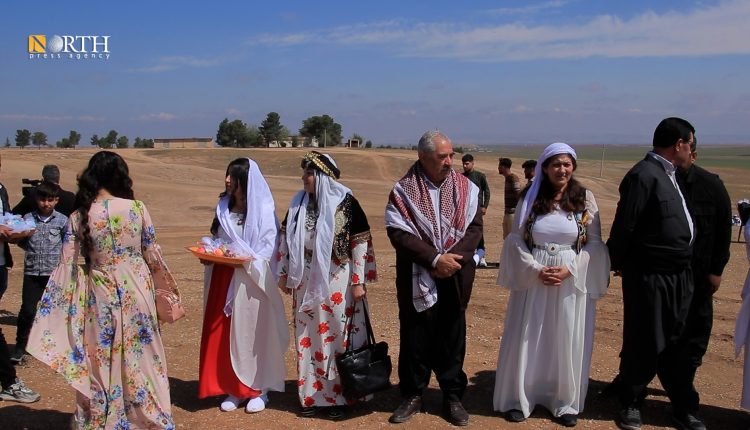Yazidis in Northeast Syria Celebrate Red Wednesday Amid Hopes for Recognition
By Kardo Roj
QAMISHLI, Syria (North Press) – Yazidi communities in northeast Syria gathered Wednesday to celebrate Red Wednesday, their New Year festival, in a colorful and symbolic ceremony held in Dokar village, located in the countryside of Amuda west of Qamishli.
The event, organized by the Ezidi House in Jazira region, was attended by local residents, community leaders, and cultural representatives. Red Wednesday, which falls on the first Wednesday of April according to the Eastern calendar, is one of the most sacred holidays in the Yazidi religious calendar.
This year’s celebration took on added significance as community leaders emphasized themes of resilience, freedom, and the importance of cultural preservation in the wake of years of marginalization and violence.
A Celebration of Resilience and Identity
“Despite the pain and trauma our people have experienced, we continue to hold onto our traditions, rituals, and festivals because they are essential to our identity,” said Leyla Ibrahim, the co-chair of the Ezidi House, in remarks to North Press during the event.
Wearing traditional garments and performing sacred rituals, attendees lit candles, decorated homes with spring flowers, and shared communal meals in accordance with ancient customs that date back centuries.
“Red Wednesday is not just a celebration—it’s an assertion of life, survival, and spiritual continuity,” added Ibrahim.
Hopes for a Pluralistic Syria
Beyond the festive spirit, the occasion also served as a platform for calls for political inclusion and constitutional recognition of the Yazidi community within Syria’s evolving governance structure.
“In this celebration, we dream of a decentralized and united Syria, where the rights of Yazidis are acknowledged in a future Syrian constitution,” said Ismail Delf, co-chair of the Ezidi House in Jazira.
He emphasized that this year’s celebration feels particularly meaningful, as Yazidis enjoy greater cultural freedom under the current administration in the region. “We celebrate our freedom and our break from the authoritarian legacy of the past,” Delf said. “We hope this New Year becomes a symbol of solidarity and pluralism.”
Cultural Preservation in AANES-Administered Regions
Northeast Syria, administered by the Autonomous Administration of North and East Syria (AANES), has become a sanctuary for many ethno-religious minorities, including Yazidis, Syriacs, Armenians, and others, who have historically faced persecution under successive regimes.
The region’s inclusive approach to governance has allowed communities such as the Yazidis to revive and openly practice their traditions, marking a shift from earlier periods of cultural suppression. Events like Red Wednesday are emblematic of the broader effort by local institutions to preserve religious and cultural heritage.
A Broader Symbol
Red Wednesday, known in Kurdish as “Çarşema Sor,” symbolizes rebirth, the arrival of spring, and the divine order of the universe in Yazidi cosmology. The day is marked by prayers at shrines, visits to cemeteries, and the tying of colored ribbons—acts that blend nature, spirituality, and communal unity.
As Syria continues to grapple with political uncertainty and security challenges, moments like this offer a rare glimpse into the resilience and hope nurtured by its diverse communities.
The Yazidis of northeast Syria continue to look to the future with cautious optimism. Their calls for constitutional guarantees reflect a broader desire among minority communities for a Syria that embraces decentralization, inclusivity, and cultural rights.
As regional actors debate the future of governance in Syria, the voices from Dokar village on Red Wednesday echo a powerful message: pluralism is not only possible—it is already in practice on the ground.

